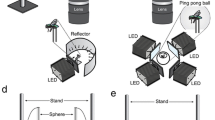Summary
-
1.
The free flight behaviour of swarming male Bibionidae (Diptera) has been filmed in the field with two cameras simultaneously at 50 frames/s. A method is described which allows the reconstruction of the three-dimensional trajectories of flies from the two films.
-
2.
Males track other flies and dummy targets from below and from downwind (Figs. 5–8; 10a). They keep pointing into the wind and control flight direction and their position relative to the target by way of translational movements (forward, side-ways and vertical movements) (Fig. 9; Fig. 16b–d). Angular tracking is minimal, there is evidence, however, that the flies roll and pitch.
-
3.
When interacting with a target, the flies keep the target's image close to and within the zone of binocular vision of their dorsal compound eyes (Figs. 3; 10c). There is some evidence that the flies' sideways acceleration is determined by the error angle velocity with a delay of 90 ms (Fig. 12). Underneath the target the flies perform sideways oscillations at 3–5 Hz (Fig. 13).
-
4.
The flies repeatedly home in on and retreat from a target. At close range (0–20 cm) their vertical and forward velocity is linearily related to the target distance (Figs. 14a, 15a). Switches from ascending to descending flight occur whenever the target is lost from the visual field of the dorsal eyes.
-
5.
Both forward and vertical velocity are to some extent dependent on the altitude of the target above the horizon of the fly (Figs. 14b, 15b).
-
6.
Rotational body movements in response to rotating striped patterns can only be elicited by stimulating the ventral eyes, the dorsal eyes do not mediate the optomotor response (Fig. 17).
-
7.
In bibionids, male-specific visually guided behaviour is mediated through the dorsal eyes only. The visual tasks of swarming males are discussed. The complex behaviour seen in males interacting with a dummy target might reflect their need to distinguish other males in a swarm from females and to keep the surrounding airspace clear of unwanted targets.
Similar content being viewed by others
Abbreviations
- DPP :
-
deep pseudopupil
References
Altner I, Burkhardt D (1981) Fine structure of the ommatidia and the occurrence of rhabdomeric twist in the dorsal eye of maleBibio marci (Diptera, Nematocera, Bibionidae). Cell Tissue Res 215:607–623
Collett TS (1980a) Some operating rules for the optomotor system of a hoverfly during voluntary flight. J Comp Physiol 138:271–181
Collett TS (1980b) Angular tracking and the optomotor response. An analysis of visual reflex interaction in a hoverfly. J Comp Physiol 140:145–158
Collett TS, King AJ (1975) Vision during flight. In: Horridge GA (ed) The compound eye and vision of insects. Clarendon Press, Oxford, pp 437–466
Collett TS, Land MF (1975a) Visual control of flight behaviour in the hoverfly,Syritta pipiens. J Comp Physiol 99:1–66
Collett TS, Land MF (1975b) Visual spatial memory in a hoverfly. J Comp Physiol 100:59–84
Collett TS, Land MF (1978) How hoverflies compute interception courses. J Comp Physiol 125:191–204
Dietrich W (1909) Die Facettenaugen der Dipteren. Z Wiss Zool 92:465–539
Downes JA (1969) The swarming and mating flight of Diptera. Annu Rev Entomol 14:271–298
Downes JA (1970) The feeding and mating behaviour of the specialized Empidinae (Diptera); observations on four species ofRhamphomyia in the high arctic and general discussion. Can Entomol 102:769–791
Franceschini N (1975) Sampling of the visual environment by the compound eye of the fly: Fundamentals and applications. In: Photoreceptor optics. Snyder, AW, Menzel R (eds) Springer, Berlin Heidelberg New York, pp 97–125
Gruhl K (1924) Die Paarungsgewohnheiten der Dipteren. Z Wiss Zool 122:205–280
Götz KG (1975) The optomotor equilibrium of theDrosophila navigation system. J Comp Physiol 99:187–210
Hausen K (1981) Monocular and binocular computation of motion in the lobula plate of the fly. Verh Dtsch Zool Ges 1981:49–70
Kirschfeld K, Wenk R (1976) The dorsal compound eye of simuliid flies: An eye specialized for the detection of small, rapidly moving objects. Z Naturforsch 31c:764–765
Land MF, Collett TS (1974) Chasing behaviour of houseflies (Fannia canicularis). J Comp Physiol 89:331–357
Maher Ali A (1957) A study of the nervous system and associated structures in the head ofBibio marci (L.). Bull Soc Entomol Egypte 41:489–523
Nachtigall W (1979) Schiebeflug bei derCalliphora erythrocephala (Diptera: Calliphoridae). Entomol Gen 5:255–265
Poggio T, Reichardt W (1973) A theory of pattern induced flight orientation of the flyMusca domestica. Kybernetik 12:185–203
Poggio T, Reichardt W (1981) Visual fixation and tracking in flies: Mathematical properties of simple control systems. Biol Cybern 40:101–112
Reichardt W (1973) Musterindizierte Flugorientierung der FliegeMusca domestica. Naturwissenschaften 60:122–138
Reichardt W, Poggio T (1976) Visual control of orientation behaviour in the fly. Part I. A quantitative analysis. Q Rev Biophys 9:311–375
Thornhill R (1980) Sexual selection within mating swarms of the lovebug,Plecia nearctica (Diptera: Bibionidae). Anim Behav 28:405–412
Wagner H (1982a) Flow-field variables trigger landing in flies. Nature 297:147–148
Wagner H (1982b) Aspekte der Kinematik und der visuellen Orientierung bei freifliegenden Stubenfliegenweibchen (Musca domestica L.). Verh Dtsch Zool Ges
Wehrhahn C (1979) Sex-specific differences in the chasing behaviour of housefies (Musca). Biol Cybern 32:239–241
Wehrhahn C, Hausen K (1980) How is tracking and fixation accomplished in the nervous system of the fly? Biol Cybern 38:179–186
Wehrhahn C, Poggio T, Bülthoff H (1982) Tracking and chasing in houseflies (Musca). Biol Cybern 45:123–130
Wenk P (1965) Über die Biologie blutsaugender Simuliiden (Diptera). II. Schwarmverhalten, Geschlechterfindung und Kopulation. Z Morphol Ökol Tiere 55:671–713
Zeil J (1983a) Sexual dimorphism in the visual system of flies: The compound eyes and neural superposition in Bibionidae (Diptera). J Comp Physiol 150:379–393
Zeil J (1983b) Sexual dimorphism in the visual system of flies: The divided brain of male Bibionidae (Diptera). Cell Tissue Res (in press)
Author information
Authors and Affiliations
Rights and permissions
About this article
Cite this article
Zeil, J. Sexual dimorphism in the visual system of flies: The free flight behaviour of male bibionidae (Diptera). J. Comp. Physiol. 150, 395–412 (1983). https://doi.org/10.1007/BF00605028
Accepted:
Issue Date:
DOI: https://doi.org/10.1007/BF00605028




